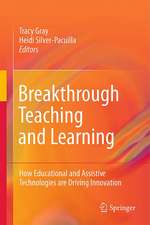3D Immersive and Interactive Learning
Editat de Yiyu Caien Limba Engleză Hardback – 4 mai 2013
The book is organized as follows. Chapter 1 introduces the fundamentals of 3D educational technology and their applications in immersive and interactive learning. Chapter 2 discusses the use of virtual reality in teaching and learning of Molecular Biology. Chapter 3 presents the daVinci Lab @ River Valley High School. Chapter 4 describes the 3D education development process. Chapter 5 studies the adaption 3D system for learning gains in lower secondary normal (technical) stream. Chapter 6 investigates the effects of virtual reality technology on spatial visualization skills. Chapter 7 showcases a sabbatical program for students to use 3D for Science, Technology, Engineering and Mathematics (STEM) learning. Chapter 8 shares the use of 3D virtual pink dolphin to assist special education. The foreword of this book is written by Dr Cheah Horn Mun, Director, Education Technology Division, Ministry of Education, Singapore.
| Toate formatele și edițiile | Preț | Express |
|---|---|---|
| Paperback (1) | 632.55 lei 6-8 săpt. | |
| Springer Nature Singapore – 12 apr 2015 | 632.55 lei 6-8 săpt. | |
| Hardback (1) | 638.76 lei 6-8 săpt. | |
| Springer Nature Singapore – 4 mai 2013 | 638.76 lei 6-8 săpt. |
Preț: 638.76 lei
Preț vechi: 751.47 lei
-15% Nou
Puncte Express: 958
Preț estimativ în valută:
122.22€ • 127.61$ • 101.16£
122.22€ • 127.61$ • 101.16£
Carte tipărită la comandă
Livrare economică 05-19 aprilie
Preluare comenzi: 021 569.72.76
Specificații
ISBN-13: 9789814021890
ISBN-10: 981402189X
Pagini: 136
Ilustrații: VII, 127 p.
Dimensiuni: 155 x 235 x 13 mm
Greutate: 0.37 kg
Ediția:2013
Editura: Springer Nature Singapore
Colecția Springer
Locul publicării:Singapore, Singapore
ISBN-10: 981402189X
Pagini: 136
Ilustrații: VII, 127 p.
Dimensiuni: 155 x 235 x 13 mm
Greutate: 0.37 kg
Ediția:2013
Editura: Springer Nature Singapore
Colecția Springer
Locul publicării:Singapore, Singapore
Public țintă
ResearchCuprins
3D Immersive & Interactive Learning.- Use of Virtual Reality in Teaching and Learning Molecular Biology.- daVinci Lab @ River Valley High School.- 3D Education Developmental Process in National Junior College: A Case Study.- Adapting 3D System for Learning Gains in the Lower Secondary Normal (Technical) Stream.- Effects of Virtual Reality Elements on Spatial Visualisation Skills of Secondary 3 Students in Singapore.- 3D Sabbatical and STEM Learning.- 3D Virtual Pink Dolphins for Special Needs Education.
Notă biografică
Dr Yiyu Cai is an Associate Professor with the College of Engineering and the Institute for Media Innovation, Nanyang Technological University (NTU), Singapore. He received multi-disciplinary trainings in Mathematics (BSc), Computer Graphics & Computer-aided Geometric Design (MSc), and Mechanical Engineering (Ph D). In NTU, he teaches Computer Graphics, Virtual Reality, Visualization, Computer-aided Design and Manufacturing, Computational Biology, etc.
Dr Cai has over 20 year research experience developing 3D technology and applications in engineering, medicine and education. His research has been supported by both public and private sectors. He has published over 150 papers in peer-reviewed international journals and conferences. He has also edited 5 books or journal special issues. He is associate editor for the journal Simulation and Gaming, and sits in editorial boards of several international journals. Part of his innovative and interdisciplinary research was or is being exhibited in Singapore Art Museum, Singapore Science Centre, and China National Science and Technology Museum. Dr Cai has co-organised many major international or regional conferences, and is keynote speakers or invited speakers for several international conferences. He has co-invented 5 patents granted or pending approval. He was former co-President of the International Simulation and Gaming Association.
Dr Cai has over 20 year research experience developing 3D technology and applications in engineering, medicine and education. His research has been supported by both public and private sectors. He has published over 150 papers in peer-reviewed international journals and conferences. He has also edited 5 books or journal special issues. He is associate editor for the journal Simulation and Gaming, and sits in editorial boards of several international journals. Part of his innovative and interdisciplinary research was or is being exhibited in Singapore Art Museum, Singapore Science Centre, and China National Science and Technology Museum. Dr Cai has co-organised many major international or regional conferences, and is keynote speakers or invited speakers for several international conferences. He has co-invented 5 patents granted or pending approval. He was former co-President of the International Simulation and Gaming Association.
Textul de pe ultima copertă
3D technology is not new; research on 3D started back in early 1960s. But unlike in previous times, 3D technology has now rapidly entered our daily life from cinema to office to home. Using 3D for education is a new yet challenging task. This book will present several innovative efforts using 3D for immersive and interactive learning covering a wide spectrum of education including gifted program, normal (technical) stream, and special needs education. The book will also share experience on curriculum-based 3D learning in classroom setting and co-curriculum-based 3D student research projects.
The book is organized as follows. Chapter 1 introduces the fundamentals of 3D educational technology and their applications in immersive and interactive learning. Chapter 2 discusses the use of virtual reality in teaching and learning of Molecular Biology. Chapter 3 presents the daVinci Lab @ River Valley High School. Chapter 4 describes the 3D education development process. Chapter 5 studies the adaption 3D system for learning gains in lower secondary normal (technical) stream. Chapter 6 investigates the effects of virtual reality technology on spatial visualization skills. Chapter 7 showcases a sabbatical program for students to use 3D for Science, Technology, Engineering and Mathematics (STEM) learning. Chapter 8 shares the use of 3D virtual pink dolphin to assist special education. The foreword of this book is written by Dr Cheah Horn Mun, Director, Education Technology Division, Ministry of Education, Singapore.
The book is organized as follows. Chapter 1 introduces the fundamentals of 3D educational technology and their applications in immersive and interactive learning. Chapter 2 discusses the use of virtual reality in teaching and learning of Molecular Biology. Chapter 3 presents the daVinci Lab @ River Valley High School. Chapter 4 describes the 3D education development process. Chapter 5 studies the adaption 3D system for learning gains in lower secondary normal (technical) stream. Chapter 6 investigates the effects of virtual reality technology on spatial visualization skills. Chapter 7 showcases a sabbatical program for students to use 3D for Science, Technology, Engineering and Mathematics (STEM) learning. Chapter 8 shares the use of 3D virtual pink dolphin to assist special education. The foreword of this book is written by Dr Cheah Horn Mun, Director, Education Technology Division, Ministry of Education, Singapore.
Caracteristici
Presents several innovative efforts using 3D for immersive and interactive learning Covers a wide spectrum of education programs including gifted program, normal (technical) stream, and special needs education Shares experience on curriculum-based 3D learning in classroom setting and co-curriculum-based 3D student research projects Includes supplementary material: sn.pub/extras



